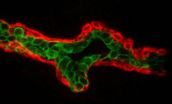Stem cells take cues from fluid in the brain
2011-03-13
(Press-News.org) Proteins in fluids bathing the brain are essential for building the brain, discover scientists in a report published March 10 in the journal Neuron. The finding promises to advance research related to neurological disease, cancer and stem cells.
Before now, the fluid surrounding the brain was generally considered to be a sort of salt-solution that simply maintained the brain's ionic balance. Recent reports of fluctuating proteins in the fluid suggested otherwise, however. And thus, a multi-institutional research teams at the Children's Hospital in Boston, led by Maria Lehtinen, Mauro Zappaterra and Christopher Walsh and researchers from the George Washington University School of Medicine and Health Sciences in Washington, D.C., decided to take a closer look at what proteins in the fluid do. What they found shocked them: As embryos and their brains are growing, a type of protein that tells brain cells to multiply increases in the so-called cerebrospinal fluid.
"This study is a game changer," says Anthony LaMantia, director of the GW Institute for Neuroscience at the GW School of Medicine and Health Sciences and an author on the paper, along with Thomas Maynard, Associate Professor of Pharmacology and Physiology at GW. "It's remarkable that signals are coming from the cerebrospinal fluid – it makes sense but no one really thought about it in this way."
Brain cells in the cortex -- the part of the brain responsible for cognition, learning and memory -- multiply and move to their appropriate position between the second and third trimester of embryonic development in humans. But until now, researchers have had little luck finding the molecular signals that direct the process as well as determining how the signals get delivered to the cells that need them.
The current team extracted cerebrospinal fluid from mouse embryos around two weeks after conception, when their brains develop most quickly. The fluid contained high levels of a protein, insulin-like growth factor or Igf2, which is known to help stem cells multiply and differentiate. Notably, the protein isn't elevated after birth. When the authors blocked Igf2, stem cells in the brain stopped making brain cells, which resulted in abnormally tiny mice brains. And when the team placed brain stem cells in a dish filled with Igf2-rich, embryonic cerebrospinal fluid, the cells proliferated rapidly. "This was clearly the environment the stem cells needed to be happy," LaMantia explains.
Brain cell proliferation is only a good thing when the time is right, however. After all, unrestrained cell multiplication leads to tumors. According to this report, Igf2 knows it's time to activate in the fluid because of proteins in long cells that surround the fluid. These long glial cells stretch from the inner part of the brain, where the fluid is, to its outer layer. They form early in brain development, and younger brain cells crawl along them during development as they find their appropriate positions like patrons filing into an opera house. At the innermost-end of the cells, at a spot called the apical domain, two proteins regulate Igf2 by altering other proteins at the surface of the glial cells, which bind to Ifg2.
If one of the steps in this pathway goes awry, Ifg2 could be activated at the wrong time causing uncontrolled proliferation. Indeed, brain cancer patients with the worst prognosis appear to have the highest levels of Igf2.
However, the fact that vital signals are sent from cerebrospinal fluid could be good news for cancer patients. "It's difficult to deliver a drug that will influence a specific spot within the brain tissue," says LaMantia. Instead, clinicians might one day infuse brain fluid with medicine – possibly one that blocks the signals from Igf2 telling cells to proliferate. "The possibilities for using the fluid as an efficient mechanism to deliver small molecule drugs are endless," he says.
Stem cell researchers now have another possible mechanism to explore in regards to how stem cells in other parts of the body differentiate and multiply. Perhaps researchers might find important proteins in what was thought to be benign fluid associated with the lungs, intestines, or other organs.
Finally, the study contributes to research on schizophrenia, autism and other neurological disorders thought to result from an erroneous arrangement of brain cells. Researchers must learn how brain development goes awry before they can design treatments, and therefore they must know how brain cells proliferate and move to the right position normally.
"This study was a massive undertaking requiring multiple labs with different resources," says LaMantia. "This is a remarkable line of investigation, and there are enormous possibilities for future work in this area."
###Funding for the study came from the National Institute of Child Health and Human Development.
About The George Washington University Medical Center
The George Washington University Medical Center is an internationally recognized interdisciplinary academic health center that has conducted scientific research and provided high-quality medical care in the Washington, D.C., metropolitan area since 1824. For more information about the GW Medical Center, visit: www.gwumc.edu
ELSE PRESS RELEASES FROM THIS DATE:
Keys to long life
2011-03-13
RIVERSIDE, Calif. - Cheer up. Stop worrying. Don't work so hard.
Good advice for a long life? As it turns out, no. In a groundbreaking study of personality as a predictor of longevity, University of California, Riverside researchers found just the opposite.
"It's surprising just how often common assumptions – by both scientists and the media – are wrong," said Howard S. Friedman, distinguished professor of psychology who led the 20-year study.
Friedman and Leslie R. Martin , a 1996 UCR alumna (Ph.D.) and staff researchers, have published those findings in "The Longevity ...
Police Focusing on Drugged Driving
2011-03-13
When most people hear about an arrest for driving under the influence, they think that the driver had too much to drink. However, the number of fatal accidents caused by drivers who are under the influence of drugs has increased over the past five years. With this number on the rise, officials are more focused on reducing the number of drugged drivers on roadways.
The National Highway Traffic Safety Administration released a study that took a deeper look at the issue. It examined drug tests that were conducted after drivers were killed in accidents. While the report ...
Creativity is an upside to ADHD
2011-03-13
Parents who believe that attention deficit hyperactivity disorder makes their kids more creative got a little more scientific support recently.
A new study in the Journal of Personality and Individual Differences found adults with ADHD enjoyed more creative achievement than those who didn't have the disorder.
"For the same reason that ADHD might create problems, like distraction, it can also allow an openness to new ideas," says Holly White, assistant professor of cognitive psychology at Eckerd College in St. Petersburg, Florida and co-author of the paper. "Not being ...
Driving with Unrestrained Pets Can Be a Deadly Distraction
2011-03-13
Most discussions about the dangers of distracted driving focus on the problems posed by electronic devices like cell phones, MP3 players and GPS navigation systems. And while many states have enacted legislation to curb the improper in-car use of electronic devices, some experts suggest that electronic devices are only part of the problem. Indeed, dangerous driving distractions can arise from a variety of sources, including one that many of us would find unlikely: our pets.
Although no definitive numbers are available, experts believe that unrestrained pets cause thousands ...
Getting organized: Berkeley Lab study shows how breast cell communities organize into breast tissue
2011-03-13
In biology, the key to a healthy life is organization. Cells that properly organize themselves into communities live long and prosper, whereas disorganized cells can become cancerous. A study by researchers with the Lawrence Berkeley National Laboratory (Berkeley Lab) of the different types of cells that make up the human breast shows that not only do cells possess an innate ability to self-organize into communities, but these communities of different types of cells can also organize themselves with respect to one another to form and maintain healthy tissue. Understanding ...
Time for Commercial Drivers to Put Down Their Cell Phones and Drive
2011-03-13
The rules of the road are becoming more specific and safety-focused, especially when it comes to regulating or banning the use of certain technological devices while driving. Late last year, the U.S. Department of Transportation (DOT) proposed one such regulation, which aims to outlaw hand-held cell phone use by interstate commercial truck and bus drivers.
This type of law is not new; many states have some form of texting while driving ban. But it is a new DOT tactic to put the enforcement spotlight on commercial drivers. The goal is to prevent trucking accidents and ...
Mouse nose nerve cells mature after birth, allowing bonding, recognition with mother
2011-03-13
PHILADELPHIA - For rodent pups, bonding with mom isn't hard-wired in the womb. It develops over the first few weeks of life, which is achieved by their maturing sense of smell, possibly allowing these mammals a survival advantage by learning to identify mother, siblings, and home.
Blending electrophysiological, biochemical, and behavioral experiments, Minghong Ma, PhD, an associate Professor of Neuroscience at the University of Pennsylvania School of Medicine, led a study published in a recent issue of the Journal of Neuroscience. With students Anderson Lee and Jiwei ...
Miniature 'wearable' PET scanner ready for use
2011-03-13
UPTON, NY - Scientists from the U.S. Department of Energy's (DOE) Brookhaven National Laboratory, Stony Brook University, and collaborators have demonstrated the efficacy of a "wearable," portable PET scanner they've developed for rats. The device will give neuroscientists a new tool for simultaneously studying brain function and behavior in fully awake, moving animals.
The researchers describe the tool and validation studies in the April 2011 issue of Nature Methods.
"Positron emission tomography (PET) is a powerful tool for studying the molecular processes that occur ...
Stena Line Predicts 100% Increase in Indian Tourists to Mainland Europe
2011-03-13
Stena Line, one of the world's largest ferry operators, has announced it is predicting a 100 per cent increase in Indian passengers in 2011 on its twice daily ferry service between Harwich and the Hook of Holland.
Some 10,000 Indian tourists travelled the route between Harwich and the Hook of Holland in 2010 and 20,000 are expected to travel it in 2011 as Indians holidaying in Europe are trying to avoid the Air Passenger Duty (APD) costs that would be incurred if they chose to fly back home from the UK.
India is in the APD band C which means that the tax has doubled ...
Untapped crop data from Africa predicts corn peril if temperatures rise
2011-03-13
A hidden trove of historical crop yield data from Africa shows that corn – long believed to tolerate hot temperatures – is a likely victim of global warming.
Stanford agricultural scientist David Lobell and researchers at the International Maize and Wheat Improvement Center (CIMMYT) report in the inaugural issue of Nature Climate Change next week that a clear negative effect of warming on maize – or corn – production was evident in experimental crop trial data conducted in Africa by the organization and its partners from 1999 to 2007.
Led by Lobell, the researchers ...

